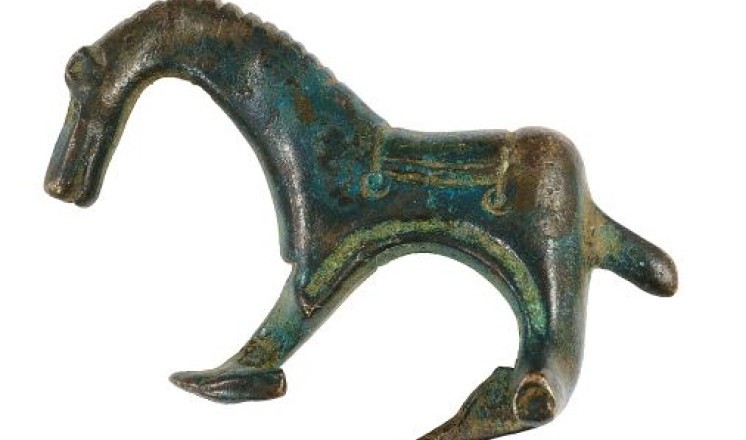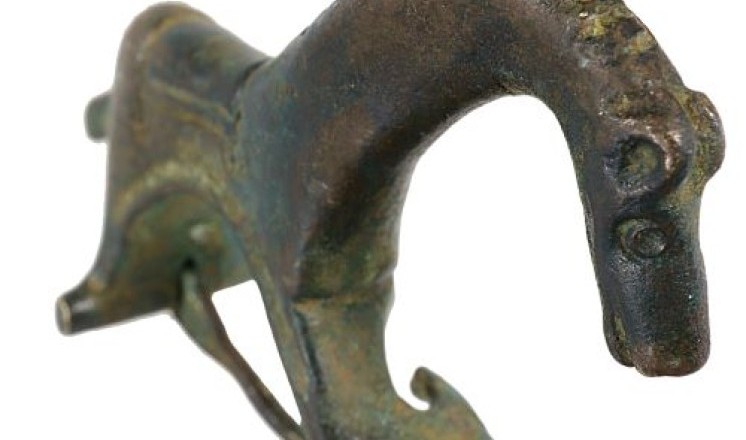Rare Roman horse brooch acquired by The Collection
RSS FeedWe're thrilled to share the news that an exciting discovery made in 2020 has now been acquired by The Collection Museum for its permanent collection. It's a complete cast copper-alloy Roman brooch in the form of a three-dimensional horse, c.AD 43-410, found near Leasingham, Lincolnshire. The brooch is an incredibly rare find in Britain, and the first three-dimensional horse brooch to be recorded on the Portable Antiquities Scheme finds database.
This brooch was discovered in early 2020 by Grantham based metal detector enthusiast Jason Price. He was taking part in a ‘Detecting for Veterans’ weekend and was in the last field of the day, which was heavily ploughed. Jason says “I didn’t hold out much hope of finding anything. You can imagine my surprise when my metal detector starting buzzing. About eight inches down I found something caked in mud. At first, I thought it was a piece of litter, but as I cleaned it off my jaw dropped open. There it was – a horse brooch. I was shaking. I’ve found things like coins before, but never anything like this. Absolutely amazing!”.
The brooch is cast copper alloy, and when originally worn would have appeared gold-like with bright enamels in the recesses. No doubt it was a prized possession of the wearer. The brooch is a fairly realistic portrayal of a horse, with details of its head, mane and saddle or saddle cloth included in the design. The hinged pin of the brooch is intact, a reflection of the remarkable condition of the whole artefact.
Dr Lisa Brundle, Lincolnshire’s Finds Liaison Officer, has described the find as “an exciting and rare discovery. This type of Roman horse brooch is incredibly rare in Britain and is the second only to have been found in the UK. The only other one is in the British Museum and is decorated differently, with spots of enamel only. The Leasingham example is in a league of its own with the pin situated below the legs and the realistic depiction of the saddle”.
The level of detail on the brooch gives it its undoubted visual appeal. It has shallow grooves for the mane, two rounded recesses for ears set fairly low, a raised dot and ridge for the eyes within recessed orbits, and a long facetted muzzle ending in shallow recesses for nostrils and a tapering groove for the mouth. A saddle or saddle blanket is suggested by deep grooves marking out a rectangular area on the horse’s back, with a double groove along each side and circles at each corner. The latter are perhaps tassel- or pom-pom-like saddle decorations.
Jason wanted the brooch to become part of the museum’s permanent collection, for visitors and researchers to enjoy, and The Collection Museum is delighted that the Friends of Lincoln Museums and Art Gallery donated funds in full to complete the purchase. The Friends’ celebrated 50 years of support for The Collection Museum, Usher Gallery and the Museum of LIncolnshire Life last year, and this is a special way in which to mark this occasion.
The brooch featured in the 'Beneath Our Feet' display at The Collection Museum in spring/summer 2021 when it was kindly loaned by Jason, and was filmed whilst in that display for the TV Series made for More4 'Great British History Hunters'. The episode featuring the horse brooch was first broadcast on Wednesday 11 May 2022. Now the brooch has been bought for the museum collection it's on display for everyone to see in our Find Out More area in The Collection before joining the Roman displays later on.
The brooch is recorded on the PAS finds database (reference LIN-09AF6A). Thanks to Dr LIsa Brundle, Lincolnshire's Finds Liason Officer, for details of the brooch, which she recorded after Jason reported the discovery to her.
Comments
There aren’t any comments for this blog yet


